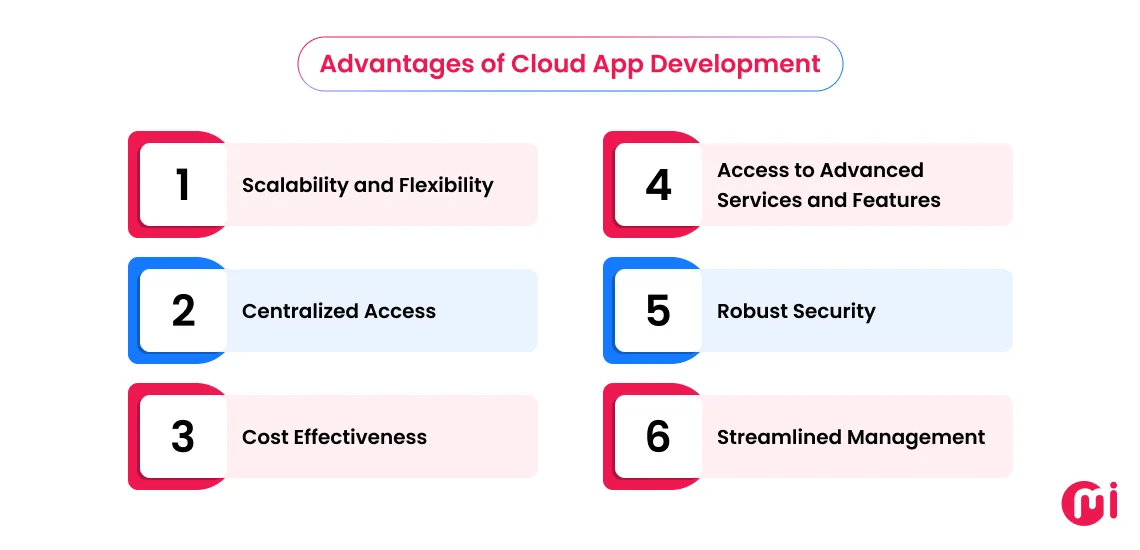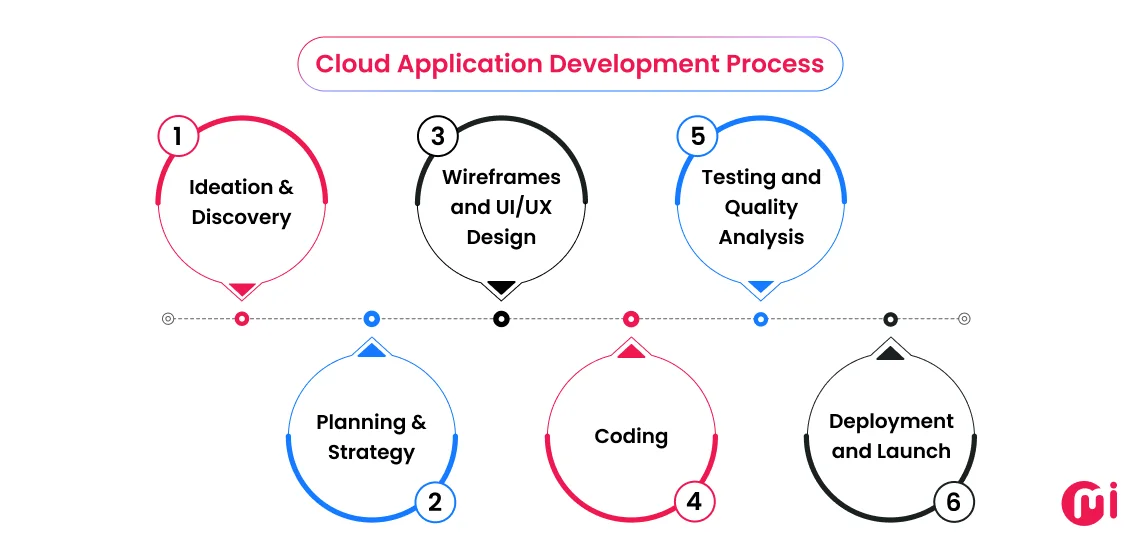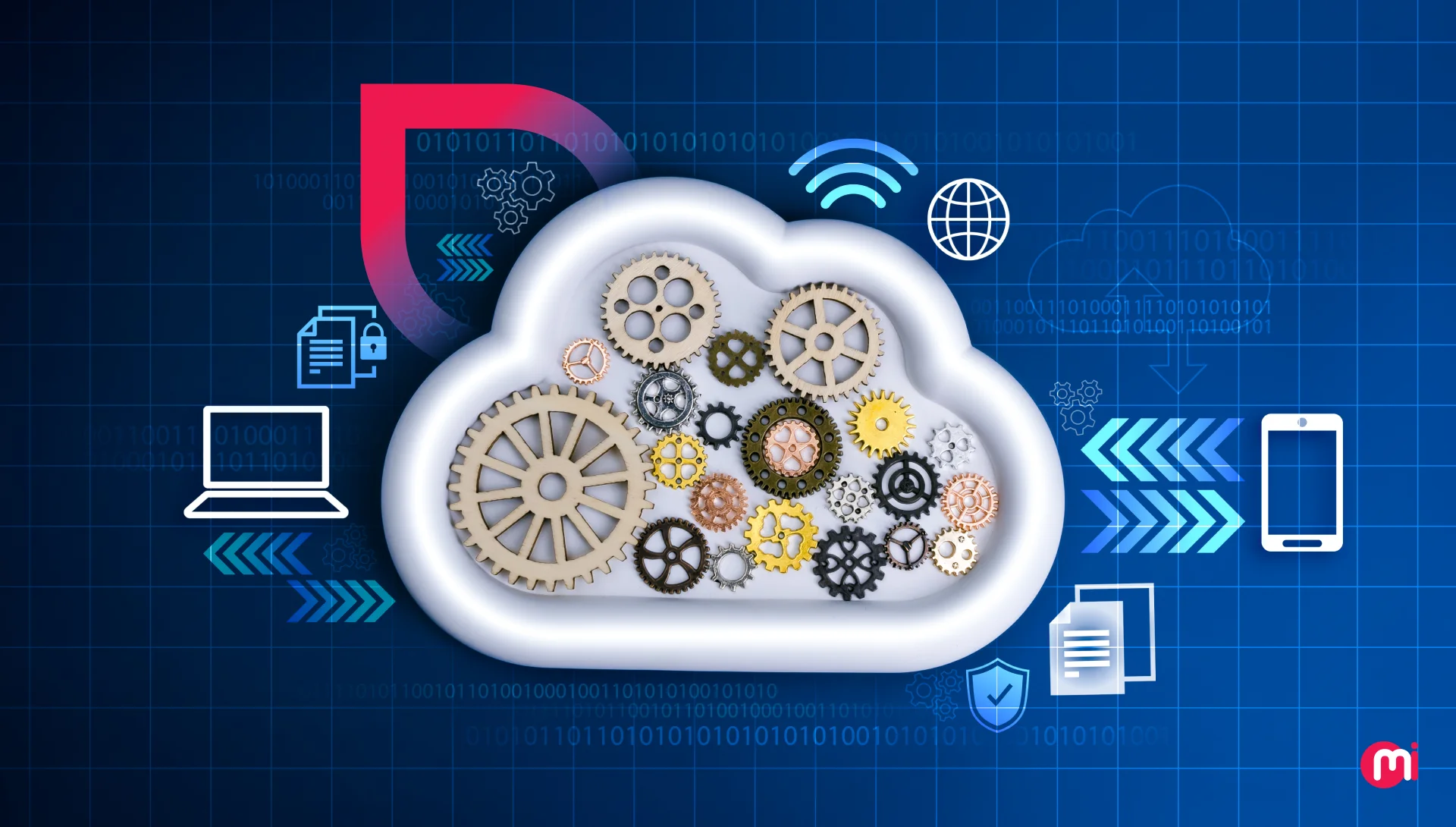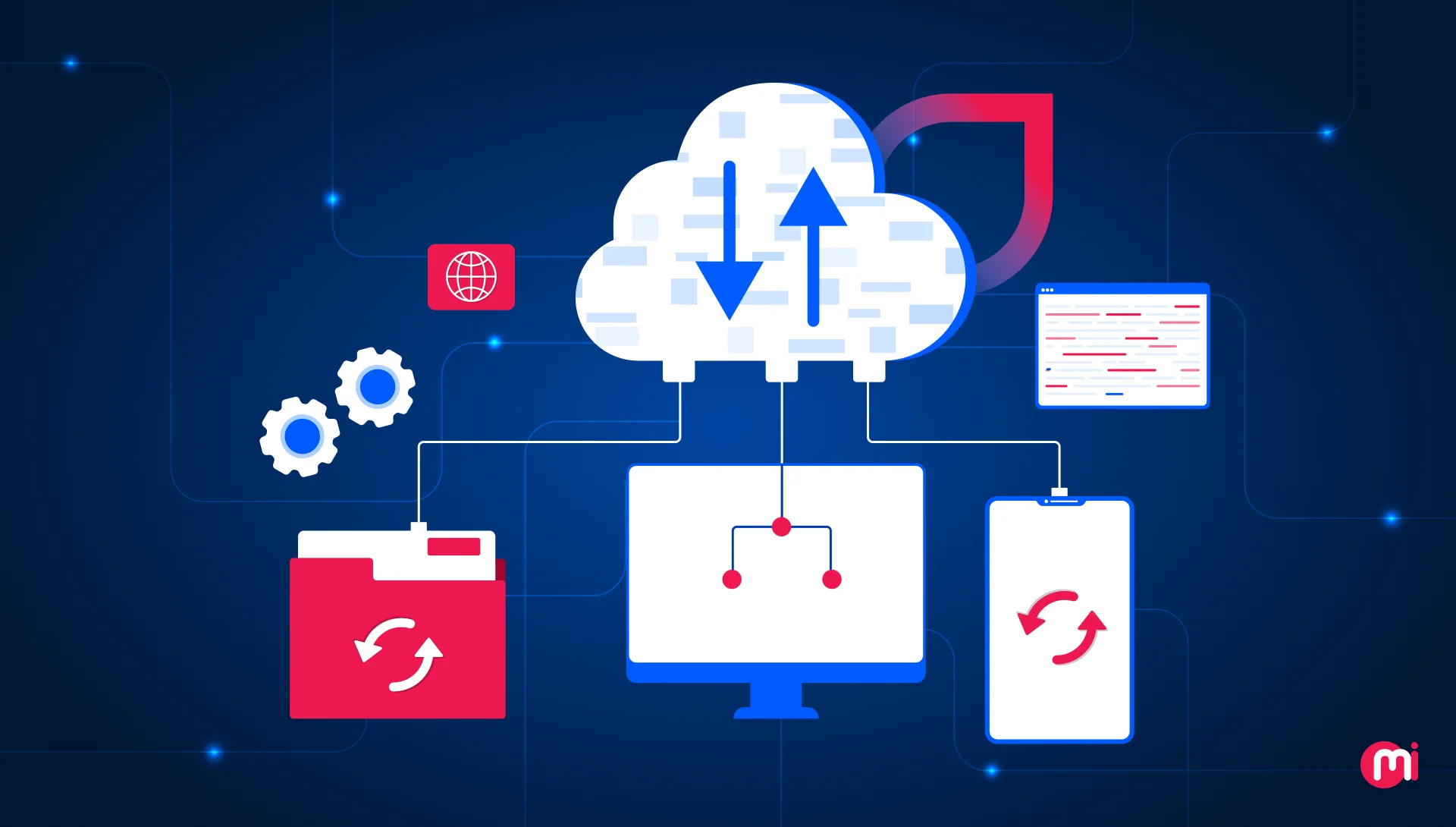Cloud Application Development Guide: Types, Process, Cost Breakdown and Timeline
- Cloud
- July 22, 2025
Cloud application development is a strategic move that shapes how your business scales, adapts, and delivers value. This blog walks you through the entire cloud application development process, outlining benefits, types, development stages, cost breakdowns, timelines, and real-world challenges so you can make informed decisions for your business. If you’re serious about building smarter, not just faster, this is where you start.
Businesses across every sector are moving to cloud-native solutions to boost scalability, cut infrastructure costs, and drive faster growth. The benefits of cloud computing are undeniable, but building a successful cloud application takes careful planning.
Choosing the right type of cloud application for your business model, taking a strategic approach to development, and controlling costs and timelines all play a critical role. By aligning these factors from the start, businesses position themselves for long-term success, avoid unnecessary expenses, and bring high-quality cloud applications to market without delays.
This blog discusses the key considerations that matter and offers insights into types of cloud applications, walks you through the development process, provides a realistic cost and timeline breakdown, and gives you enough reasons to invest.
What is Cloud Application Development?
Cloud application development is the process of designing, building, and deploying applications that run in cloud environments, rather than on local servers or individual devices. These apps use cloud infrastructure and services to ensure scalability, flexibility, high availability, and cost efficiency.
Cloud applications can be accessed over the internet and are built using models like SaaS (Software as a Service), PaaS (Platform as a Service), or IaaS (Infrastructure as a Service), depending on the business needs and technical requirements.
Benefits of Cloud Application Development
For companies aiming to stay agile, cloud application development offers several strategic advantages. Here’s how it can support growth and improve operational efficiency:

1. Scalability and Flexibility
Cloud-based applications scale as your business grows, whether you need to support more users, roll out new features, or manage higher workloads; the infrastructure adjusts instantly. This flexibility enables faster time-to-market, supports growth across regions, and ensures your systems remain resilient under pressure while keeping operational overhead in check.
2. Centralized Access
With cloud solutions, teams can access applications and data securely from any location. This centralized access supports remote work, improves collaboration, and ensures consistency across departments and devices.
3. Cost Effectiveness
Cloud platforms operate on a pay-as-you-go model. You only pay for what you use, avoiding upfront infrastructure costs and reducing ongoing maintenance expenses. It makes budgeting more predictable and cost control more achievable.
4. Access to Advanced Services and Features
Leading cloud providers offer a wide range of built-in tools, from AI and machine learning to real-time analytics and automation. These services accelerate development and improve your app’s capabilities without the need for additional third-party integrations.
5. Robust Security
Security is a top priority in cloud environments, especially for businesses managing sensitive data, financial transactions, or regulated workloads. Leading cloud providers invest heavily in enterprise-grade security infrastructure. This includes advanced encryption, identity and access management, compliance-ready frameworks, DDoS protection, and 24/7 monitoring. With built-in tools and continuous updates, your applications remain secure, resilient, and aligned with industry standards.
6. Streamlined Management
Managing cloud applications is more efficient and less resource-intensive compared to traditional systems. Automatic updates, performance monitoring, and simplified maintenance workflows reduce manual overhead. Cloud platforms also offer centralized dashboards and management tools, making it easier to track usage, optimize resources, and ensure system health in real time. It leads to better operational control, faster issue resolution, and improved service delivery across departments.

Different Types of Cloud Applications
The three main types of cloud applications are Infrastructure as a Service (IaaS), Platform as a Service (PaaS), and Software as a Service (SaaS). Each serves a different purpose depending on how much control, flexibility, and responsibility you want over your infrastructure and software stack.
1. Infrastructure-as-a-Service (IaaS)
IaaS provides on-demand access to essential computing resources, including servers, storage, and networking, without the need to manage physical hardware. It’s ideal for businesses that want full control over their application environment but don’t want to invest in or maintain on-premise infrastructure.
This model supports high scalability, flexible configurations, and pay-as-you-use pricing, making it a strong fit for companies running custom applications or dynamic workloads.
2. Platform-as-a-Service (PaaS)
PaaS offers a ready-to-use platform where developers can build, test, and deploy applications without managing the underlying infrastructure. It streamlines the software development lifecycle (SDLC) and takes care of operating systems, middleware, and runtime environments.
For businesses looking to speed up software delivery and reduce complexity, PaaS allows teams to focus on writing code and bringing products to market while the platform handles scaling, updates, and security behind the scenes.
3. Software-as-a-Service (SaaS)
SaaS delivers functional software over the internet, and installation, infrastructure, and maintenance aren’t required on the user’s side. It’s the most user-friendly model and is typically offered on a subscription basis.
From CRM platforms to accounting tools, SaaS applications help businesses get up and running quickly while reducing IT overhead. They’re especially valuable for improving operational efficiency and enabling remote access across teams.
Also read: SaaS Development Guide: A Comprehensive Analysis of SaaS Development
How to Develop a Cloud Application: Step-by-Step Process
The cloud application development process includes key steps such as ideation & discovery, planning & strategy, wireframes and UI/UX design, coding, testing and quality analysis, to deployment and launch. Each phase plays a critical role in helping you develop a cloud application.
Here’s a detailed breakdown of each stage:

1. Ideation & Discovery
The ideation and discovery phase shapes the concept into a functional and reliable model. At this stage, you are not writing code or designing interfaces but contemplating the process and building clarity around what needs to be built and why.
You must identify the problem the application will solve, the pain points it will address for your users or internal teams, and gaps that exist in current systems or workflows. After this, define your goals and decide what you are looking for, whether you want to improve internal operations, launch a new product, or create a tool that supports your customers.
The clearer your goals, the easier it is to decide what your cloud app needs to do and how success will be measured. During discovery, you also look at the bigger picture, your target users, the market landscape, and existing solutions. It’s about research, not assumptions, as it includes analyzing competitors, reviewing similar tools, and identifying what they do well or where they fall short.
By the end of the discovery phase, you should have a clear product vision, a list of core features, and a solid understanding of what the app needs to achieve from both a technical and business perspective.
2. Planning & Strategy
This stage bridges the gap between “what you want to build” and “how you’re going to build it.” At this stage, your focus shifts to aligning goals and timelines, technology, resources, and budget. Hence, outline the core features of the application that are essential for launch, and prioritize the most important for better outcomes.
The planning phase involves selecting the right cloud model (IaaS, PaaS, or SaaS) and deciding on cloud platforms like AWS, Google Cloud, or Azure. These decisions directly affect scalability, performance, cost, and maintenance. In this stage, define the cloud app architecture, user roles, data flows, and system requirements. You will get clarity on how each part of the app will function, who it’s for, and what kind of infrastructure it will need to perform well.
Also, you must decide how many developers, designers, and QA experts will be involved, and how long each stage will take, its key milestones and delivery checkpoints to track progress and manage risk. Create a document outlining the roadmap and including project scope, timelines, responsibilities, and a clear direction. It sets the tone for the entire development process and helps avoid scope creep, miscommunication, or wasted effort later on.
3. Wireframes and UI/UX Design
The wireframes and UI UX design process is where your cloud application truly comes to life and takes center stage. This stage defines how users will navigate your product, access key features, and get things done efficiently.
Ask your team to create wireframes to visualize the user journey and catch usability issues early. Also, ensure the core flow of the app makes sense before investing time in high-fidelity designs or development. Now, map out where content, buttons, forms, and menus will go without distractions like color or styling. Review and refine wireframes and ask them to create a software prototype that helps you interact with the app and its design early.
Now move to UI (User Interface) design and decide its fonts, colors, icons, branding elements, and interactive behaviors that create an interface that’s both attractive and functional. Now, focus on the user experience design and make your application easy for users to navigate features, make it accessible in a few clicks and do the design work equally on desktop, tablet, and mobile.
4. Cloud Based Application Development
This stage translates design and strategy into a fully functioning cloud-based solution. This stage is divided into two parts: frontend development and backend development.
Developers build interfaces using technologies like HTML, CSS, JavaScript, and modern frontend frameworks, including Angular, React or Vue. They focus on speed, and responsiveness, and ensure the interface works smoothly across devices and browsers.
They handle user authentication, data storage, server-side logic, third-party integrations, and other backend aspects of the cloud application. They use programming languages like Node.js, Python, or others, depending on project needs.
For enterprise-level app development, teams might also implement microservices, containerization, or multi-cloud infrastructure to support scalability and reliability. Throughout this phase, developers follow agile software development practices and iterative methods.

5. Testing and Quality Analysis
The testing and quality analysis (QA) process ensures your cloud app works as intended across all use cases, platforms, and user roles. This stage makes sure the product is stable, secure, fast, and user-friendly before it ever reaches the end user.
QA engineers start the process with functional testing and check whether every feature performs correctly or not. From login authentication to data input, file uploads, third-party integrations, and user dashboards, each component is tested against the original requirements.
They conduct performance testing to ensure the system performs under pressure, without crashes, slowdowns, or data loss. After this, they test the security to scan for vulnerabilities, check access controls, and ensure compliance with industry standards. Testers finish the process with cross-device and cross-browser testing to confirm that your cloud app works smoothly across operating systems and browsers.
6. Deployment and Launch
Deployment and launch are the final steps where your cloud application moves from testing to a live production environment. It involves setting up infrastructure, configuring CI/CD pipelines, and running final checks to ensure everything works smoothly.
For enterprise mobile app development, a phased rollout or soft launch is often used to reduce risk and gather early feedback. After going live, real-time monitoring and managed services help maintain performance, fix issues quickly, and ensure a smooth user experience.

How Much Does it Cost to Develop a Cloud Application?
The cost to develop a cloud application can range anywhere from $30,000 to $250,000+, depending on several key factors such as application complexity, feature set, integration needs, and the expertise and location of your development team.
| Application Type | Estimated Cost Range | Involved Features |
| Simple Cloud Application | $25,000 to $60,000+ | Basic features, limited backend logic, MVPs, internal tools, or single-function apps |
| Mid-Level Application | $40,000 to $100,000+ | Multiple user roles, dashboards, third-party integrations, moderate scalability |
| Enterprise-Grade Solution | $100,000 to $250,000+ | Custom infrastructure, real-time processing, multi-cloud, AI/ML, high security, compliance, maintenance |
Tools and Technologies Used in Cloud Application Development
Building a cloud application involves many tools and technologies, including frontend, backend, infrastructure, and cloud engineering services. The tech stack is responsible for app performance, scalability, and long-term maintainability. Here’s a breakdown of the most widely used technologies in developing cloud-based applications:
| Category | Technologies and Tools |
| Frontend Development | React, Angular, Vue.js |
| Backend Development | Node.js, Python (Django/Flask), |
| Database | PostgreSQL, MySQL, MongoDB, Firebase, Amazon RDS |
| Cloud Platforms | AWS, Google Cloud Platform (GCP), Microsoft Azure |
| DevOps & CI/CD | Docker, Kubernetes, Jenkins, GitHub Actions, GitLab CI/CD |
| Storage Solutions | Amazon S3, Google Cloud Storage |
| APIs & Integrations | RESTful APIs, GraphQL, gRPC, Stripe, Twilio, OAuth |
| Authentication | Firebase Auth, Auth0, AWS Cognito, Okta |
| Monitoring & Logging | New Relic, Datadog, Prometheus, ELK Stack, CloudWatch |
| AI/ML Integration | TensorFlow, PyTorch, Amazon SageMaker, Google Vertex AI, Azure ML |
| Serverless Frameworks | AWS Lambda, Google Cloud Functions, Azure Functions |

Cloud Application Development Challenges and Their Solutions
Cloud application development challenges can impact scalability, cost-efficiency, and long-term performance. Its common pain points include security risks, unpredictable costs, integration hurdles, and ensuring consistent reliability.
Overcoming these obstacles while developing cloud-based applications requires a clear cloud migration strategy backed by strong infrastructure planning, proactive monitoring, and the right technology choices. Here’s a look at common challenges businesses face and their solutions:
1. Security
Data breaches, unauthorized access, and compliance gaps are major concerns in cloud environments.
Solution: Adopt end-to-end encryption, enforce strict identity and access management (IAM), and choose cloud providers with built-in compliance tools. Conduct regular audits and penetration testing.
2. Performance Issues
Latency, downtime, or slow load times can degrade user experience and affect business outcomes.
Solution: Use content delivery networks (CDNs), auto-scaling capabilities, and performance monitoring tools to maintain consistent response times under varying loads.
3. Cost Management
Without proper tracking, cloud expenses can spiral out of control due to unused resources or poor planning.
Solution: Implement usage monitoring, set budgets and alerts, and use cloud cost optimization tools offered by cloud providers to track and reduce waste.
4. Integration Complexities
Connecting cloud apps with legacy systems or third-party tools often creates compatibility and synchronization issues.
Solution: Use APIs, integration platforms, and middleware that simplify data exchange and avail cloud integration services from a reliable provider. Plan architecture with integration in mind from the start.
5. Vendor Lock-in
Relying heavily on one cloud provider can limit flexibility and increase switching costs later.
Solution: Design apps using open standards and containerized environments to support portability across platforms.
6. Scalability
Poorly designed applications may struggle to handle traffic spikes or increased usage.
Solution: Build a scalable architecture with microservices, auto-scaling groups, and stateless components to handle growth without rework.
7. Reliability
System outages or failures can result in lost revenue or damaged reputation.
Solution: Deploy across multiple availability zones or use multi-cloud strategies. Implement failover mechanisms, regular backups, and disaster recovery plans.
8. Lack of Expertise
Building and managing cloud apps requires specific technical skills that many internal teams may lack.
Solution: Partner with experienced cloud development teams, invest in staff training, and leverage managed services when needed.
Conclusion
Cloud application development is beyond cloud migration. It’s about building solutions that are flexible enough to evolve with your business, resilient enough to scale under pressure, and smart enough to integrate seamlessly across systems. The real challenge isn’t in choosing the right cloud model or cloud cost optimization, but it’s in making sure your application delivers long-term value without creating technical debt.
As organizations rethink how they deliver digital services, the winners will be those who treat the cloud not just as infrastructure but as a foundation for innovation, speed, and adaptability.

Got A Cloud App Idea? Build It With MindInventory
MindInventory drives your digital transformation forward with precision-engineered cloud application development services tailored to your unique business goals. Whether you’re building a high-performing SaaS platform, launching a scalable enterprise-grade system, or modernizing legacy infrastructure into a cloud-native ecosystem, we deliver high-end solutions that support your organization’s growth.
From initial strategy and architecture design to development, deployment, and continuous optimization, we cover the full spectrum of cloud services. Our team specializes in building robust, secure, and scalable cloud applications across AWS, Google Cloud, and Azure, using the latest in serverless computing, microservices, Kubernetes, and CI/CD automation to deliver performance without compromise.
We align our development cycles with your business vision, keeping transparency, agility, and innovation at the core. You bring the idea. We bring the engineering precision, cloud strategy, and product-thinking mindset to make it real and make it last.
FAQs on cloud solutions
A cloud application is used to deliver software or services over the internet instead of through local machines. Businesses use cloud apps for everything from data storage and collaboration to managing operations and customer interactions. These apps make it easier to access information from anywhere and scale as needed. They’re also useful for reducing infrastructure costs and improving overall flexibility.
Cloud APIs offer several advantages that help businesses streamline operations and build scalable applications more efficiently. They enable easy integration between different cloud services and platforms, saving time on development. With cloud APIs, teams can automate tasks, access cloud resources on demand, and enhance functionality without building everything from scratch. They also support faster innovation, better flexibility, and reduced maintenance overhead.
The time to develop a cloud application ranges from 6 months to 2 years and more, depending on the scope, complexity, and specific business requirements. A simple cloud application, such as an MVP or a tool, can be built in 6 months and mid-level applications with custom features take 6 months to 1 year or more. Meanwhile, complex enterprise-level app development may require 1 year to 3 years or more.
The cloud model is useful because it provides on-demand access to computing resources like storage, servers, and software without the need for heavy upfront investment. It allows businesses to scale quickly, reduce infrastructure costs, and improve operational efficiency. The model also supports remote access, faster deployment, and better disaster recovery options, making it a smart choice for both startups and large enterprises.
The three types of cloud computing are public cloud, private cloud, and hybrid cloud. Each serves different operational needs and scalability goals. Choosing the right model depends on your business priorities, compliance requirements, and long-term strategy.
Some real-life examples of cloud applications include Google Workspace (Docs, Sheets, Gmail), Microsoft 365, Dropbox, Salesforce, and Slack. These apps allow users to access data, collaborate, and perform tasks from anywhere with an internet connection. They’re widely used across industries for productivity, communication, storage, and customer management.
The future of cloud computing looks highly promising, with continued growth in AI integration, edge computing, and multi-cloud strategies. Businesses are increasingly moving toward more flexible, scalable, and cost-effective cloud environments to support innovation. As security, automation, and real-time data processing advances, cloud computing will play an even bigger role in digital transformation across industries.













